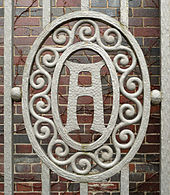Fritz Ahrberg sausage factory
The sausage factory Fritz Ahrberg was a German company in the meat industry , which was based in Hanover in the Linden-Süd district . Similar to his competitor Johann Weishäupl , the butcher Fritz Ahrberg founded his company in 1911, which existed until 1992. From 1998 the former factory premises were converted into the residential and commercial area of the Ahrbergviertel .
history
The trained butcher Fritz Ahrberg opened a butcher shop in Linden in 1896 . The business developed so well, partly because of the demand from the workers at the nearby Hanomag factory, that Ahrberg was able to expand. In 1911 he acquired the site of today's Ahrbergviertel and had a four-story factory building built on it. He himself moved into the existing villa on the site. She had Bethel Henry Strousberg built in the 1860s as director of the machine factory opposite Georg Egestorff (later Hanomag ).
The sausage factory processed up to 120,000 halves of pork delivered from the Hanover slaughterhouse every year . From this meat, liver sausage and other types of sausage were made. The company was considered exemplary because of its high hygiene standards, among other things the cooling and processing rooms were tiled. The company expanded in the 1930s, when the buildings of a neighboring bed spring factory were taken over. The sausage factory's boiler house, which was built in 1918 from red bricks and is no longer part of the Ahrberg district, is striking. In the past, the energy for sausage processing was generated in it, and it also served as a smoke chamber for smoking the sausage. The boiler house still has the sausage factory Fritz Ahrberg lettering set in clinker brick and the lower part of the once 58 m high chimney.
The Ahrberg company quickly recovered from the aftermath of the Second World War, in which part of the factory buildings were destroyed in the air raids on Hanover . Due to the increased consumption of meat and sausages in the post-war period , the company experienced an enormous boom. It increased the number of branches that were now also located in other cities in Lower Saxony . The high-quality meat and sausage products sold well throughout Germany and abroad due to their quality. Specialties were bouillonwurst and Thuringian meatballs, as well as sausages in the style of the Calenberger Land . At the height of the company's history, the company had over 1,200 employees.
After high losses, which the company explained as the population's reduced meat consumption, the company found itself in economic difficulties in 1991. In 1992 the Ahrberg heirs sold the family business to a sausage company from Saarbrücken . Ahrberg was the last industrially run meat product chain company in Hanover. In 2001 the Gramann slaughterhouse from Pattensen took over the naming rights and has since sold its products worldwide under the Ahrberg name.
Entrance gate to the former Fritz Ahrberg sausage factory, today's Ahrbergviertel
literature
- Karl Johaentges , Uta Preuße: Ahrberg - new life in the sausage factory (illustrated book), Hanover: KaJo, 2002, ISBN 3-925544-27-5
- Waldemar R. Röhrbein : AHRBERG, Fritz. In: Dirk Böttcher , Klaus Mlynek, Waldemar R. Röhrbein, Hugo Thielen : Hannoversches Biographisches Lexikon . From the beginning to the present. Schlütersche, Hannover 2002, ISBN 3-87706-706-9 , p. 25; online through google books
- Waldemar R. Röhrbein: Ahrberg, Fritz A. GmbH, meat and sausage products. In: Klaus Mlynek, Waldemar R. Röhrbein (eds.) U. a .: City Lexicon Hanover . From the beginning to the present. Schlütersche, Hannover 2009, ISBN 978-3-89993-662-9 , p. 16.
- Christiane Schröder, Sid Auffarth , Manfred Kohler: Potash, coal and canal - industrial culture in the Hanover region , ed. by Axel Priebs on behalf of the Hanover Region , Rostock: Hinstorff, 2010, ISBN 978-3-356-01378-8
Web links
Individual evidence
- ↑ Waldemar R. Röhrbein: AHRBERG, Fritz (see literature)
- ^ Ernst Büttner: Hanover, the capital of Lower Saxony , Stuttgart: Franckh, 1937, p. 59; online through google books
Coordinates: 52 ° 21 ′ 40.6 " N , 9 ° 42 ′ 56.5" E




